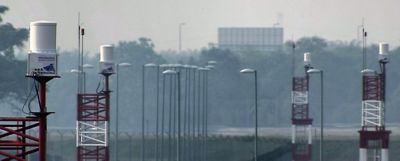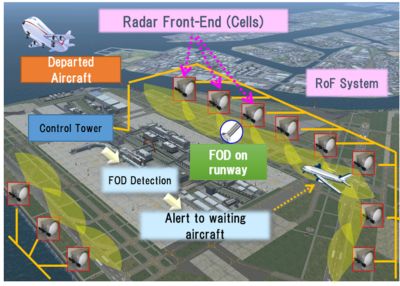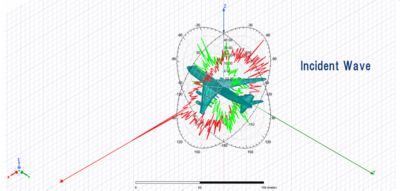ANSYS BLOG
May 12, 2022
Cleaning Up Runway Junk with Millimeter Wave Radars
There are lots of “unseen” risk factors involved in flying that most of us probably take for granted, including stuff frequently found lying around the runway. At Birmingham Airport in the U.K., for example, crews from three different planes recently reported seeing an object on the runaway after several near misses during landing. Apparently during routine maintenance, a 7-foot ladder fell off the back of a truck and landed in the touchdown zone (the first point of contact for a plane during landing). After a third aircraft reported seeing debris, the tarmac was shut down completely to identify and remove the ladder, which was positioned at an angle that could have caused considerable damage to a plane. This incident ended well, thanks to quick observations of the flight crews involved. But what could happen with debris you don’t see?

Hitachi radar antenna unit at KLIA
Probably the deadliest of all debris-related crashes occurred in 2000, when a supersonic Concord airliner crashed five minutes after taking off from Charles de Gaulle Airport in Paris. Upon investigation, it was revealed that the cause of the crash was a 42-cm-long piece of metal that had fallen from a preceding aircraft onto the runway, puncturing the fuel tank and causing the airplane to burst into flames, killing everyone onboard. To help ensure this and other debris-related incidents would not happen again, Hitachi Kokusai Electric participated in a government project to develop millimeter wave radars for detecting foreign objects on runways using Ansys’ software and high-performance computing solutions.
Hitachi Kokusai Electric Inc., headquartered in Tokyo, Japan, is a company that manufactures broadcasting systems, security and surveillance systems, wireless communications, and information systems. Its work on millimeter wave radar systems for the purpose of foreign object detection was supported by the government project “Research and Development of Advanced Radio Frequency Spectrum,” from the Ministry of Internal Affairs and Communications (MIC) of Japan.
It's a Bird. It’s a Plane. It’s an FOD?
Foreign object debris, or “FOD,” is the technical term for airport junk. It can be classified as anything in an airport environment that pose risks to people or planes as they land, take off, or taxi, whether it’s metal shed from an aircraft, rocks, building materials, or pieces of luggage, ground equipment or even maintenance vehicles. No matter how innocuous it may seem, this debris can cause significant damage to aircraft on airport runways, cargo aprons, taxiways, and run-up pads. According to Boeing, the aerospace industry loses approximately $4 billion every year due to damage caused from the stuff, which can seize engines if ingested, cut aircraft tires during take-offs and landings, and find its way into aircraft mechanisms, rendering them unusable.
When you factor in the number of flights coming in and out of airports, plus a lack of visibility during inclement weather and nighttime conditions, airport inspections of heavily trafficked surface areas — either by vehicle or on foot — are impractical. Even with a sufficient workforce in place, there’s an inherent risk of some objects being overlooked or missed completely due to their location and size. The right radar system can help mitigate these risks with faster, more accurate detection of hard-to-find metal objects like the one involved in the Concord crash. Recently, with help from Ansys software, Hitachi Kokusai Electric participated in a government project to develop millimeter wave radars for detecting FODs on runways to improve safety and reduce loss.

Millimeter-wave-radar system diagram
Large Electrical Problems Require Ansys Software Solutions
Working in cooperation with Malaysia Airports (Sepang) and Unversiti Teknologi Malaysia (UTM), Hitachi Kokusai Electric embarked on the development of a system that would be initially tested and implemented at Kuala Lumpur International Airport in Malaysia’s capital. During testing, they determined that, given the electrical size of the problem they were trying to solve, Ansys HFSS offered the most effective solver technologies for this analysis. Among the capabilities of the HFSS high-frequency software solution, the team relied heavily on the HFSS integral equation (IE) method of the moments (MoM)-based solver, as well as the asymptotic capabilities of the SBR+ solver, which can handle large models very effectively. HFSS provides multiple solvers for a range of analysis scales in one integrated user interface, enabling the use of different solvers for different analysis purposes. Access to a variety of solvers in one tool enabled Hitachi Kokusai Electric’s engineers to use different analysis methods in HFSS depending on their analysis target.

Example FOD model and surface current calculated by the integral equation method
Because the foreign object detection system is designed to detect small metallic foreign bodies, the radar cross section (RCS; bistatic) of the airplane was needed to study interferences in the system and enable frequency sharing with earth exploration satellites with adjacent frequencies. Using the HFSS Shooting and Bouncing Rays (SBR+) solver enabled Hitachi Kokusai Electric to simulate large airplanes at 90 GHz. In this instance, HFSS was used for radar cross section (RCS) calculations, i.e. those involving the equivalent area seen by the target necessary for system evaluation to account for potential interferences created by the presence of the plane on the runway.
“Due to the nature of our analysis, it was necessary to mesh (represent) the entire analysis space,” says Nobuhiko Shibagaki, Senior Engineer at Hitachi Kokusai Electric. “In such cases we use Ansys HFSS-IE solver or SBR+ solver, which can effectively handle large-scale models. HFSS offers solvers that can be implemented according to the scale of analysis and used within an integrated user interface, so it is easy to use different solvers according to the analysis’ purpose.”

Bistatic RCS of B747 airplane calculated at 90 GHz by SBR+
Considering what’s at stake for both passengers and crew, the goal was to achieve the highest level of FOD detection possible. Combining Hitachi Kokusai Electric’s optical surveillance camera system with a linear cell radar system resulted in a complete FOD detection solution involving radars with exceptional coverage, resolution, and nighttime probability compared to typical optical cameras. Deploying millimeter wave radar with the 90-GHz band using RoF (radio over fiber) technology along the runway, the system scans the entire runway by utilizing radio waves to efficiently and accurately detect metal objects. It then reports the accurate location information of the object or objects discovered to avoid runway closure.
Once an unwanted metal object is detected by radar, system transmission of FOD location information, along with the FOD image captured by a high-sensitivity camera, is transmitted almost instantaneously — 10 seconds from detection of a 3-cm metal piece over a distance of 500 m. Basic performance of foreign object detection (FOD) radar was confirmed in the demonstration system installed at Narita International Airport and Kuala Lumpur International Airport.
Soaring Through the Cloud
During system development, Hitachi Kokusai Electric found its licenses were sometimes insufficient due to conflicts among users, which made it impossible to run HFSS analysis on demand. Ansys Cloud provided Hitachi Kokusai Electric with a practical solution to these challenges in an affordable, pay-as-you-go high-performance computing environment. With support from Ansys Cloud, the study was run on an H16mr virtual machine powered by Microsoft Azure, featuring 16 Intel® Xeon® processor cores. With this Ansys Cloud on Intel configuration, simulations ran 20 times faster than on-premise simulation, reducing run times to 10 hours versus 8 1/2 days outside of the cloud.
“Ansys Cloud solved our problem of having a limited amount of Ansys HFSS licenses, which sometimes prevented me from having access to the simulation software when I needed it,” says Shibagaki. “Now, with Ansys Cloud, it is available for me to use it whenever I need to run an analysis quickly. It is a very convenient system that allows us to have an ideal machine environment without a huge investment. I will continue to use HFSS effectively in the development of millimeter wave radars by combining the local Ansys HFSS and Ansys Cloud as necessary.”
Interested in accessing the Ansys hardware and software you need, when you need it, paying only for what you use? Sign up for the Ansys Cloud free trial to learn more about this scalable, cost-effective approach to HPC in the cloud.